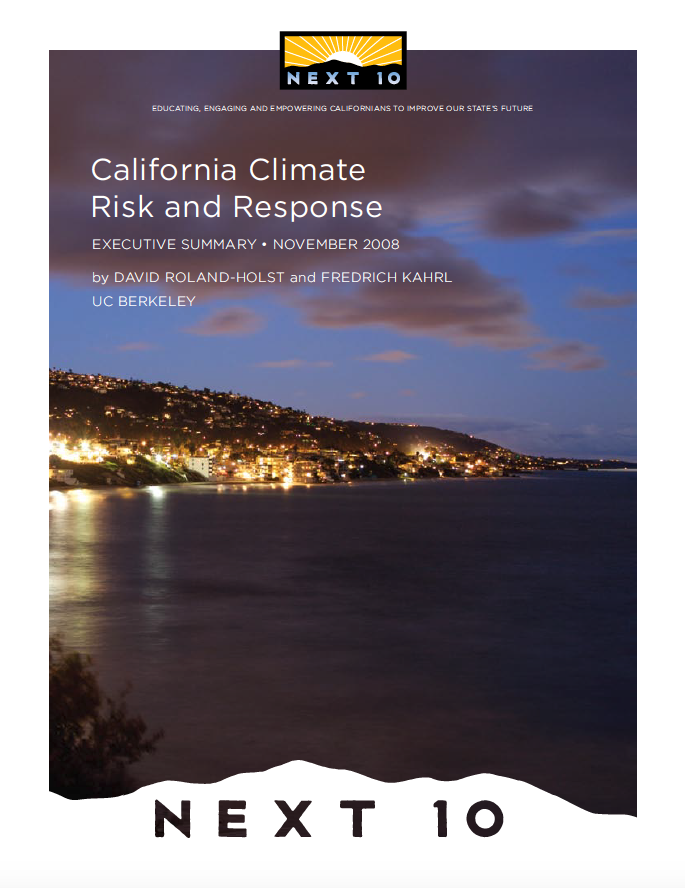Publications
California Climate Risk and Response
This report provides for the first time a comprehensive examination of the economic impacts of climate change and adaptation in California. In conducting this multi-sector assessment, we compile the most recent available science on climate damage, assess its economic implications, and examine alternative strategies for adaptation.
Taken together, real estate and insurance represent the largest economic climate risk for California, yet they are the least studied to date. The report finds that the state has $4 trillion in real estate assets, of which $2.5 trillion are at risk from extreme weather events, sea level rise, and wildfires, with a projected annual price tag of $300 million to $3.9 billion over this century, depending on how warm the world gets. If no action is taken in the face of rising temperatures, six additional sectors, including water, energy, transportation, tourism and recreation, agriculture, and public health, would together incur tens of billions per year in direct costs, even higher indirect costs, and expose trillions of dollars of assets to collateral risk.
Economic Damage and Asset Risk Estimates for California
|
|||||||||||||||||||||||||||||||||||||||||||||||||||||||
Note: Please see the Executive Summary for detailed notes and source documentation in the Additional Resources tab.
Climate response – mitigation to prevent the worst impacts and adaptation to climate change that is unavoidable -- on the other hand, can be executed for a fraction of these net costs by strategic deployment of existing resources for infrastructure renewal/replacement and significant private investments that would enhance both employment and productivity.
At the sector level, there will be some very significant adjustment challenges, requiring as much foresight and policy discipline as the state can mobilize. In this context, the political challenges may be much greater than the economic ones. The state’s adaptation capacity depends upon flexibility, but divergence between public and private interests may limit this flexibility. As in the current financial dilemma, resolving this will require determined leadership.
Despite the extent and high quality of existing climate research reviewed in this document, the degree of uncertainty regarding many important adjustment challenges remains very high. This uncertainty is costly, increasing the risk of both public and private mistakes and the deferral of necessary adaptation decisions. The process of improving research and understanding of climate effects may itself be costly and difficult, but policymakers must have better visibility regarding climate risk and response options.
Core findings on sectoral impacts include:
- There will be significant sector adjustments, of which the political obstacles may be more formidable than economic ones. The state's adaptation capacity depends on flexibility, but divergence between public and private interests may limit this adaptability.
- The annual economic impacts of climate-induced damage in the energy sector will range from $2.7 billion in the low-warming scenario to $6.3 billion in the high-warming scenario. Overall, $21 billion in energy assets are at risk.
- Combined estimates show that Californians could face from $200 million to $1.4 billion in additional annual water damage costs from climate change and from $100 million to $2.5 billion in annual fire damage costs, depending on the level of warming. The state has over $900 billion of assets at risk because of water and $1.6 trillion in assets at risk because of fire.
- Insurance exposure for near-shore property in California could approach half of a trillion dollars.
- There are an estimated $5 billion in assets at risk in the water sector; damage costs for the high-warming scenario are projected to reach $600 million a year. Adaptation, particularly if it is delayed, could add hundreds of millions of dollars to existing renewal and replacement costs.
- There are an estimated $500 billion of transportation sector assets at risk. Climate adaptation needs to be integrated into a broader vision and dialogue about California's transportation infrastructure: where and how it is built, retrofitted or rebuilt, and how it is financed. Less development in high-risk areas could limit damage.
- There are $98 billion in tourism and recreation assets at risk, with a projected annual price tag of $200 million to $7.5 billion in climate damage costs, depending on which warming scenario comes to pass.
- Agriculture, forestry, and fisheries combined have $113 billion in assets exposed to climate damage, with an annual price tag of $300 million if climate is stabilized, to over $4.3 billion in the highest-warming scenario.
- The public health sector faces from $3.8 billion to $24 billion in additional annual costs associated with climate change impacts.
